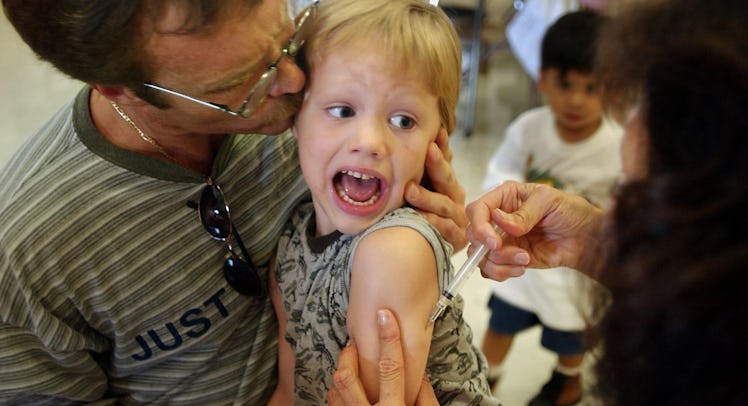If Anti-Vaxxers Win Over Even a Few Parents, the Effects Could Be Devastating
Even a slight decline in the MMR vaccine could have devastating effects.

Just a five percent drop among kids who receive the measles, mumps, and rubella vaccination could cause measles cases to spike threefold annually, according to new research. The study, published in JAMA Pediatrics, projects that these additional incidences will increase public health costs by at least $2.1 million, or $20,000 per case. Given that unvaccinated children tend to cluster geographically, this may mean that future outbreaks are possible, and that means a lot of sick kids with a host of related health problems, including shortened lives.
“From my standpoint, measles seems destined to return in states such as Texas, as it has this spring and summer in Minnesota,” Dr. Peter Hotez, Dean of the National School of Tropical Medicine at the Baylor College of Medicine, told Fatherly. Hotez is also a vaccine scientist, pediatrician, and the father to a daughter with Autism.
Using data obtained from the Centers for Disease Control and Prevention, Hotez and his colleagues created a mathematical model to simulate county-level MMR vaccine coverage for children ages 2 to 11 years old in present day America. Then they simulated what a measles outbreak would look like following two chance events, accounting for more than 10,000 scenarios. First, they looked at what would happen when a person visiting an endemic area returned to their country and interacted with multiple people. Then they looked at what would happen if an unvaccinated child exposed to measles did the same.
“We asked if such declines precipitate measles outbreaks such as they have in Europe recently, especially in Romania and elsewhere,” Hotez explains.
Results revealed a 93 percent MMR coverage rate, with non-medical exemptions making up 2 percent, with 48 cases annually. However, they found that just a 5 percent decline would increase this by three times that, up this to 150 cases. When the simulations estimated the price of declining vaccination rates in children 2 and younger, public health costs went up another $400,000 on top of the $2.1 million projection “The findings show that our nation’s immunization coverage is fragile, and that drops in the 18 U.S. states that allow non-medical exemptions could precipitate measles outbreaks,” Hotez says.
While all 50 states currently require the MMR vaccine and other childhood vaccinations prior to enrollment in elementary school or day care, children can be exempted for medical and non-medical reasons. Mississippi, West Virginia, and California (which notably eliminated all non-medical exemptions following the 2015 measles outbreak at Disneyland) are the only states that don’t allow parents to decline vaccines for religious reasons, and 18 states allow exemptions for non-medical and non-religious personal beliefs. And that means a lot more children are at risk of becoming victims of anti-science rhetoric and otherwise eradicated diseases.
Having experienced it first hand, Hotez understands that is a complicated and emotional decision for parents and is skeptical that these findings will change all of their minds. “But it might prompt pediatricians and pediatric nurse practitioners to work harder to convince parents to vaccinate their kids.”